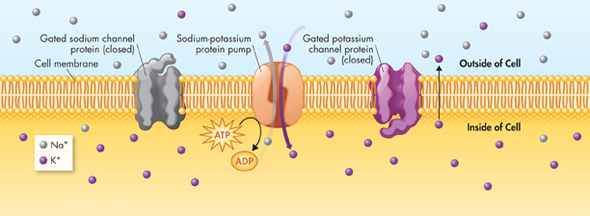The Nerve Impulse
 How does a nerve impulse begin?
How does a nerve impulse begin?
Nerve impulses are a bit like the flow of an electric current through a wire. To see how this occurs, let's first examine a neuron at rest.
The Resting Neuron Neurons, like most cells, have a charge, or elec-trical potential, across their cell membranes. The inside of a neuron has a voltage of −70 millivolts (mV) compared to the outside. This difference, or resting potential, is roughly one-twentieth the voltage in a flashlight battery. Where does this potential come from?
Active transport proteins pump sodium ions (Na+) out of the cell and potassium ions (K+) into it as shown in Figure 31–3. Since both ions are positively charged, this alone doesn't produce a potential across the membrane. However, ungated potassium channel proteins make it easier for K+ ions than Na+ ions to diffuse back across the membrane. Because there is a higher concentration of K+ ions inside the cell as a result of active transport, there is a net movement of positively charged K+ ions out of the cell. As a result, the inside becomes negatively charged compared to the outside, producing the resting potential.
MYSTERY CLUE

The toxin found in this fish binds to gated sodium channels, blocking the flow of Na+ ions into a cell. How do you think this might affect muscle movement?
The Moving Impulse A neuron remains in its resting state until it receives a stimulus large enough to start a nerve impulse.  An impulse begins when a neuron is stimulated by another neuron or by the environment. Once it begins, the impulse travels quickly down the axon away from the cell body toward the axon terminals. In myelinated axons, the impulse moves even more rapidly as its skips from one node to the next.
An impulse begins when a neuron is stimulated by another neuron or by the environment. Once it begins, the impulse travels quickly down the axon away from the cell body toward the axon terminals. In myelinated axons, the impulse moves even more rapidly as its skips from one node to the next.
What actually happens during an impulse? As Figure 31–5 shows, the impulse itself is a sudden reversal of the resting potential. The neuron cell membrane contains thousands of “gated” ion channels. At the leading edge of an impulse, gated sodium channels open, allowing positively charged Na+ ions to flow into the cell. The inside of the membrane temporarily becomes more positive than the outside, reversing the resting potential. This reversal of charges, from more negatively charged to more positively charged, is called a nerve impulse, or an action potential.

FIGURE 31–3 The Resting Neuron The sodium-potassium pump in the neuron cell membrane uses ATP to pump Na+ ions out of the cell and to pump K+ ions in. A small amount of K+ ions diffuse out of the cell (through ungated channels), but gated channels block Na+ ions from flowing into the resting neuron. Apply Concepts Is the action of the sodium-potassium pump an example of diffusion or active transport? Explain.
dTable of Contents
- Formulas and Equations
- Applying Formulas and Equations
- Mean, Median, and Mode
- Estimation
- Using Measurements in Calculations
- Effects of Measurement Errors
- Accuracy
- Precision
- Comparing Accuracy and Precision
- Significant Figures
- Calculating With Significant Figures
- Scientific Notation
- Calculating With Scientific Notation
- Dimensional Analysis
- Applying Dimensional Analysis




